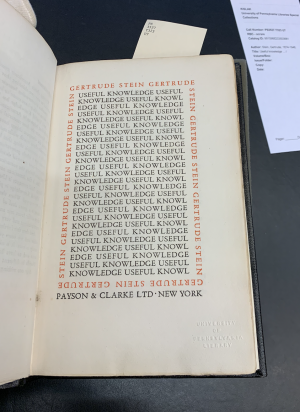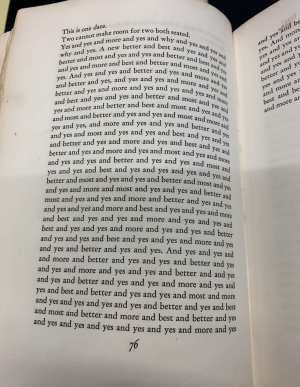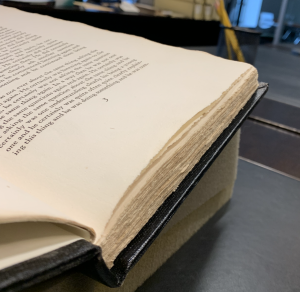Useful Knowledge

Useful Knowledge is a book of short stories and poems written between 1914 and 1926 by famed novelist Gertrude Stein.[1] It was published in 1929, making the book one of Stein's first 10 published works of her career which consisted of over 40 such volumes. In an advertisement for the book, Stein described Useful Knowledge as being "pleasant and therefore it is very much to be enjoyed." In lockstep with much of Stein's other work at the time, Useful Knowledge was unique in the way it placed and worded text, making it a distinctive work of modernism. A first-edition copy of the book is stored at the Kislak Center for Special Collections, Rare Books, and Manuscripts.
Background
Gertrude Stein
Gertrude Stein wrote novels, poems, plays, as well as collected art over the course of her 72-year life span. She was born in Allegheny, Pennsylvania, but was raised in Oakland, California. In 1903, Stein moved to Paris, France, and remained in France for the duration of her life. The Harvard University and Johns Hopkins University alumnus hosted a Paris salon, where famous modernist artists in the fields of literature and art would meet. The list of names of people who attended included Pablo Picasso, Ernest Hemingway, F. Scott Fitzgerald, Sinclair Lewis, Ezra Pound, Sherwood Anderson and Henri Matisse. With over 40 published works over the course of her lifetime, Stein became known as "the mother of modernism" for the distinctive way in which she crafted her prose.[2]
Modernist Literary Movement

During the early 1900s until the early 1940s, a new form of literature arose in the form of modernism. The style, of which Gertrude Stein employed in much of her writing, was known for the way in which it tinkered with the common traits of linear narrative. Modernism arose in response to the horrors perceived during World War I. The form allowed artists to portray the fragmented, unsettling world around them by largely tossing reason and normalcy aside. In Stein’s case, much of her writing adhered to this style in the way in which she would use repetition. In her poems and short stories alike, Stein would often repeat the same word or set of words over and over again. In poetry, this is not entirely out of the norm, but within the short story format, Stein’s writing bucked the standard conventions through her usage of continual repetition.[2] Additionally, instead of the traditional left-to-right style of printed text, Stein’s writing, particularly in Useful Knowledge, would often start on the right side or start on the left and skip the middle portion of the allotted space. This modernist feature made her printed text more dynamic than that of much of her counterparts. Outside of Stein, other modernist artists during the early 20th century included author Virginia Woolf as well as painter Pablo Picasso.
Material Analysis
Cover and Title Page
In the Kislak Center, the first-edition copy of Useful Knowledge possesses a solid black cover with no words or images. The spine of the book contains the title as well as Stein’s last name. As such, the cover of the book does not reflect the subversive properties that exist within it. However, on the title page of the book, Stein’s modernist qualities are reflected through its unique structuring. A rectangle is lined from top to bottom with repetitions of the title, Useful Knowledge, and lining the rectangle are red repetitions of the author’s name, Gertrude Stein. The usage of repetition is a clear tie-in to the book’s continual usage of the same effect, in which Stein often repeats words, even lining entire pages with the same set of them. In addition to reflecting the rest of the book, the title page is a modernist interpretation of a standard cover page. Instead of a generic singular printing of the title and author, Useful Knowledge’s cover page subverts this and is as fragmented and unsettling as many other pieces of modernist text. This modernist contrast is illustrated by the way in which the page also mentions Payson & Clarke Limited, the book’s original publishing company. Their name is thrown in at the bottom just once. In doing so, Stein (or whoever else came up with this title page) eloquate that Stein and the book itself are modernist and subversive, while the book’s publishing company is merely a separate entity not engaging with this convention-breaking. In future editions of the book, like the one currently available on Amazon that's sold by Station Hill Press, a different publishing company, the cover is the title page of the first-edition Kislak Center copy. What this tells us is that the new publisher likely made the original title page the cover in order to give a more reflective microcosm of the book right off the bat. When it was originally published, modernism had not run its course yet and was not entirely recognized by the general population. So the original cover, plain and solid black, was likely a way of conforming an otherwise distinctive, groundbreaking text into an aspect of the established medium.
Page Material

The book itself is made of a material thicker than paper, but not quite parchment. That, in and of itself, is not particularly noteworthy about the book's material structure, but what is interesting is its deckle edge. The pages of Useful Knowledge contain a feathered edge as opposed to a cut edge, meaning the book is not uniform in the way its edges are shaped. This feature gives the book a much more artistic, handmade appearance, which is something that Stein has been quoted as intending to make her books feel. Deckle edges largely went out of style once smooth edges were introduced in the 19th century, so the utilization of it by Useful Knowledge was likely a conscious choice by Stein, especially considering her artistic intention as an author. First-edition copies of her book up until the mid-1940's also contained deckle edges, signaling that deckle edges were indeed a facet of her books that she included in order to add to the artistic feel.[3]
Page Structure
Throughout the bulk of Useful Knowledge, the words on each page only take up roughly half of the given space. In particular, the top and bottom of each page is devoid of text, with all the words being housed by the center of the page. This is in contrast to most other books of the time period, which utilize a greater portion of the space on each page. Although the initial impetus can be to attribute this to the book's printing process (which could very likely be the case), it's also possible that this was an intended feature by Stein. With less text on each page, the book feels more artistic than if it was packed to the brim with words, as is almost always the case with textbooks or other similar books that solely intend to convey information. Additionally, there are pages which repeat the same word or set of words over and over again, and then the following page is relatively standard. By making each page a certain length, Stein had the ability to structure her work in the way she seemingly meant to, with a certain amount of repetitions and then a successive series of standard pages. So behind the unique page structuring could have very well been Stein's influence in keeping her art a certain way. In future editions of the book, the spacing is far less distinctive, with more conventional structuring being utilized, so either Stein's influence over her own text wore off once she passes away, or the first-edition spacing could have been a product of flawed, of-the-time printing.
Textual Analysis
Content

In Useful Knowledge, Stein covers terrain ranging from how the South differs from the North, the city of Chicago, war, and Woodrow Wilson. Interestingly, many of her subject matters concern topics in or relating to the United States, despite the fact that she was living in France when she wrote Useful Knowledge. It falls in line with much of her other work, as she often preferred to write about where she came from as opposed to where she was during the writing process. Stein writes in both short story and poem format. In line with much of her other work, there is a lot of repetition of words as well as reciprocal clauses and sentences that come one after another.
Themes
Despite being a collection of short stories and poems written over a 12-year period on a variety of different subjects, Useful Knowledge is tied together by the theme of people's sexual and imaginative lives. Specifically, Stein argues for "redress" and "excess" in both areas.[1] Another key theme Stein hones in on is guilt. In many passages, she uses rhymes and repetition to explain the way her conscience feels burdened by the guilt she carries around and how it effects her.[1] One vital feature of modernism, abstractionism, is also utilized by Stein to demonstrate her feelings and opinions on the themes she touches on. Abstractionism relies on the mind connecting various concepts through experience and reappraisal, and Stein employs modernist forms of repetition and fragments to extract the value of it.[4] In particular, Stein uses trigger words regarding sex and guilt that spark a cognitive connection for the reader and helps elucidate an emotion from them.
Reception and Legacy
Publishing Troubles
During much of her career, Stein struggled to break into the American publishing marketplace because of her unique literary style. Popular magazines and commercial printing houses deemed her work "incomprehensible" and "unintelligible." Prior to 1933, Stein only had four books of hers published in America, including Useful Knowledge. In order to make that happen, however, Stein had to work with smaller printing presses that required her to pay the printing costs herself and didn't offer advertising or distribution channels.[5] People in the American printing industry would often inform her of grammatical errors she had, all of which were likely intentional. Finally, in 1933, Stein published The Autobiography of Alice B. Toklas, which boomed in America and allowed her greater leeway in the U.S. Before that, however, Useful Knowledge struggled to make much headway in America due to the obstacles Stein faced in even getting it into the marketplace.[5]
Disappearance from Print
In 1988, Station Hill Press re-released Useful Knowledge. In the publishing company's description of the book, they described it as having been absent from print for 60 years, meaning since roughly 1928, right around when the book was published, it vanished. The reason behind this is unknown, but it makes the Kislak Center's copy far more rare, as first-edition copies of Useful Knowledge are few and far between.
References
- ↑ 1.0 1.1 1.2 Fifer, Elizabeth. “Guardians and Witnesses: Narrative Technique in Gertrude Stein's Useful Knowledge.” The Journal of Narrative Technique 10, no. 2 (1980): 115–27.
- ↑ 2.0 2.1 Will, Barbara. Gertrude Stein, modernism, and the problem of "genius". Edinburgh University Press, 2013.
- ↑ Stein, Gertrude. “Wars I Have Seen by Gertrude Stein - First Edition; First Printing - 1945 - from Sage Rare & Collectible Books, Ioba (SKU: 860).” Biblio.com. Random House, 1945. https://www.biblio.com/book/wars-i-have-seen-stein-gertrude/d/1307846773.
- ↑ Hoffman, Michael J. The Development of Abstractionism in the Writings of Gertrude Stein. Philadelphia: University of Pennsylvania Press, 2016.
- ↑ 5.0 5.1 Conrad, Bryce. “Gertrude Stein in the American Marketplace.” Journal of Modern Literature 19, no. 2 (1995): 215–33.